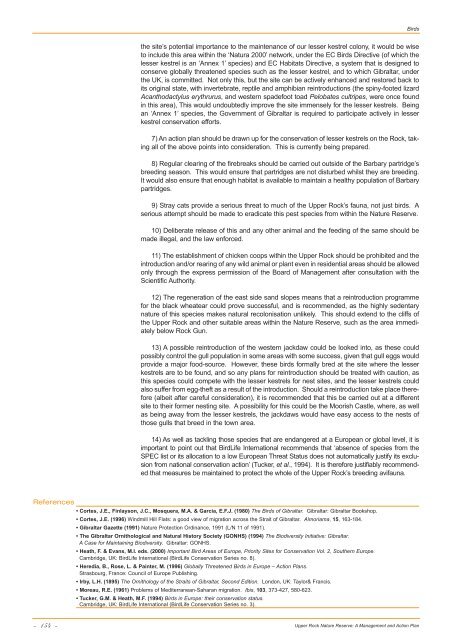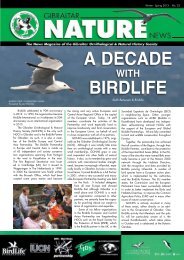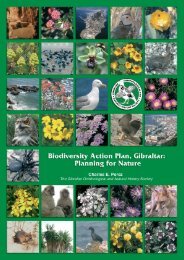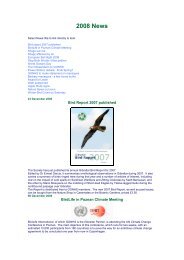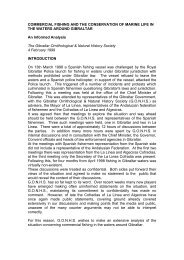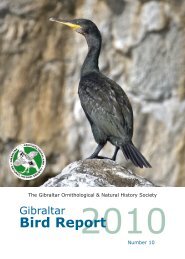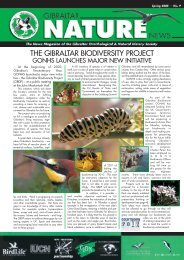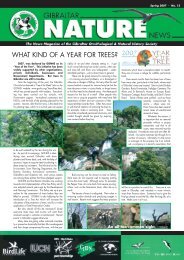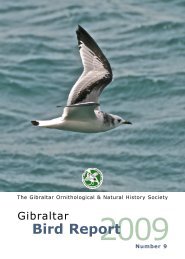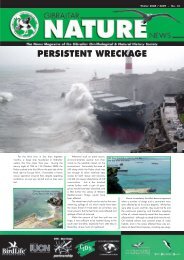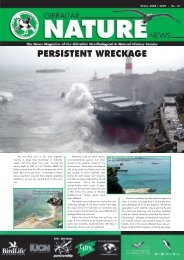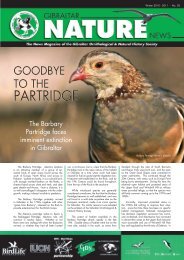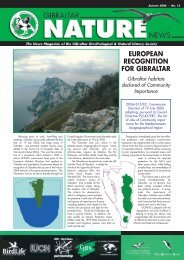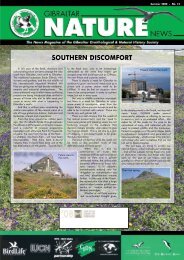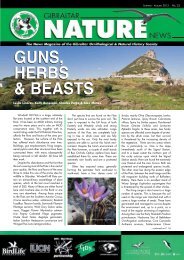Upper Rock Nature Reserve: A Management and Action Plan
Upper Rock Nature Reserve: A Management and Action Plan
Upper Rock Nature Reserve: A Management and Action Plan
You also want an ePaper? Increase the reach of your titles
YUMPU automatically turns print PDFs into web optimized ePapers that Google loves.
- 154 -<br />
the site’s potential importance to the maintenance of our lesser kestrel colony, it would be wise<br />
to include this area within the ‘Natura 2000’ network, under the EC Birds Directive (of which the<br />
lesser kestrel is an ‘Annex 1’ species) <strong>and</strong> EC Habitats Directive, a system that is designed to<br />
conserve globally threatened species such as the lesser kestrel, <strong>and</strong> to which Gibraltar, under<br />
the UK, is committed. Not only this, but the site can be actively enhanced <strong>and</strong> restored back to<br />
its original state, with invertebrate, reptile <strong>and</strong> amphibian reintroductions (the spiny-footed lizard<br />
Acanthodactylus erythrurus, <strong>and</strong> western spadefoot toad Pelobates cultripes, were once found<br />
in this area), This would undoubtedly improve the site immensely for the lesser kestrels. Being<br />
an ‘Annex 1’ species, the Government of Gibraltar is required to participate actively in lesser<br />
kestrel conservation efforts.<br />
7) An action plan should be drawn up for the conservation of lesser kestrels on the <strong>Rock</strong>, taking<br />
all of the above points into consideration. This is currently being prepared.<br />
8) Regular clearing of the firebreaks should be carried out outside of the Barbary partridge’s<br />
breeding season. This would ensure that partridges are not disturbed whilst they are breeding.<br />
It would also ensure that enough habitat is available to maintain a healthy population of Barbary<br />
partridges.<br />
9) Stray cats provide a serious threat to much of the <strong>Upper</strong> <strong>Rock</strong>’s fauna, not just birds. A<br />
serious attempt should be made to eradicate this pest species from within the <strong>Nature</strong> <strong>Reserve</strong>.<br />
10) Deliberate release of this <strong>and</strong> any other animal <strong>and</strong> the feeding of the same should be<br />
made illegal, <strong>and</strong> the law enforced.<br />
11) The establishment of chicken coops within the <strong>Upper</strong> <strong>Rock</strong> should be prohibited <strong>and</strong> the<br />
introduction <strong>and</strong>/or rearing of any wild animal or plant even in residential areas should be allowed<br />
only through the express permission of the Board of <strong>Management</strong> after consultation with the<br />
Scientific Authority.<br />
12) The regeneration of the east side s<strong>and</strong> slopes means that a reintroduction programme<br />
for the black wheatear could prove successful, <strong>and</strong> is recommended, as the highly sedentary<br />
nature of this species makes natural recolonisation unlikely. This should extend to the cliffs of<br />
the <strong>Upper</strong> <strong>Rock</strong> <strong>and</strong> other suitable areas within the <strong>Nature</strong> <strong>Reserve</strong>, such as the area immediately<br />
below <strong>Rock</strong> Gun.<br />
13) A possible reintroduction of the western jackdaw could be looked into, as these could<br />
possibly control the gull population in some areas with some success, given that gull eggs would<br />
provide a major food-source. However, these birds formally bred at the site where the lesser<br />
kestrels are to be found, <strong>and</strong> so any plans for reintroduction should be treated with caution, as<br />
this species could compete with the lesser kestrels for nest sites, <strong>and</strong> the lesser kestrels could<br />
also suffer from egg-theft as a result of the introduction. Should a reintroduction take place therefore<br />
(albeit after careful consideration), it is recommended that this be carried out at a different<br />
site to their former nesting site. A possibility for this could be the Moorish Castle, where, as well<br />
as being away from the lesser kestrels, the jackdaws would have easy access to the nests of<br />
those gulls that breed in the town area.<br />
14) As well as tackling those species that are endangered at a European or global level, it is<br />
important to point out that BirdLife International recommends that ‘absence of species from the<br />
SPEC list or its allocation to a low European Threat Status does not automatically justify its exclusion<br />
from national conservation action’ (Tucker, et al., 1994). It is therefore justifiably recommended<br />
that measures be maintained to protect the whole of the <strong>Upper</strong> <strong>Rock</strong>’s breeding avifauna.<br />
References<br />
• Cortes, J.E., Finlayson, J.C., Mosquera, M.A. & Garcia, E.F.J. (1980) The Birds of Gibraltar. Gibraltar: Gibraltar Bookshop.<br />
• Cortes, J.E. (1996) Windmill Hill Flats: a good view of migration across the Strait of Gibraltar. Almoriama, 15, 163-184.<br />
• Gibraltar Gazette (1991) <strong>Nature</strong> Protection Ordinance, 1991 (L/N 11 of 1991).<br />
• The Gibraltar Ornithological <strong>and</strong> Natural History Society (GONHS) (1994) The Biodiversity Initiative: Gibraltar.<br />
A Case for Maintaining Biodiversity. Gibraltar: GONHS.<br />
• Heath, F. & Evans, M.I. eds. (2000) Important Bird Areas of Europe, Priority Sites for Conservation Vol. 2, Southern Europe.<br />
Cambridge, UK: BirdLife International (BirdLife Conservation Series no. 8).<br />
• Heredia, B., Rose, L. & Painter, M. (1996) Globally Threatened Birds in Europe – <strong>Action</strong> <strong>Plan</strong>s.<br />
Strasbourg, France: Council of Europe Publishing.<br />
• Irby, L.H. (1895) The Ornithology of the Straits of Gibraltar, Second Edition. London, UK: Taylor& Francis.<br />
• Moreau, R.E. (1961) Problems of Mediterranean-Saharan migration. Ibis, 103, 373-427, 580-623.<br />
• Tucker, G.M. & Heath, M.F. (1994) Birds in Europe: their conservation status.<br />
Cambridge, UK: BirdLife International (BirdLife Conservation Series no. 3).<br />
Birds<br />
<strong>Upper</strong> <strong>Rock</strong> <strong>Nature</strong> <strong>Reserve</strong>: A <strong>Management</strong> <strong>and</strong> <strong>Action</strong> <strong>Plan</strong>


